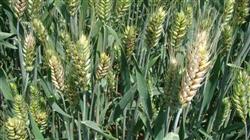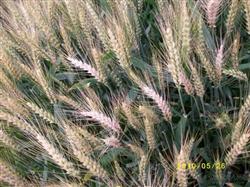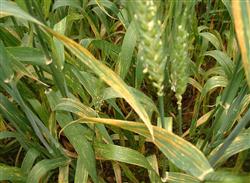What happens to the cause of wheat scab?

What causes wheat scab? Please introduce wheat scab in detail: 1. The influence and variety of wheat scab on quality. All the important wheat regions in our country have suffered from scab. In recent years, the occurrence frequency of scab was high in north Henan, which had great influence on wheat quality. Scab toxin problem. Fusarium oxysporum can produce a variety of toxins. Group B toxin in trichothecin is a kind of toxin that can cause vomiting and abortion in human beings. There are two kinds of group B toxin: fusarium enol (NIV) and deoxyfusarium enol (DON). Therefore, the control of wheat scab is not only related to food security but also related to food security. There is obvious differentiation of scab toxin in wheat growing areas of China, and the pathogen population of wheat scab in China is a problem. Many experts have studied the pathogen of Fusarium graminearum in China, and they all think it is Fusarium graminearum. With the progress of research and the expansion of the concept of species, Fusarium graminearum is no longer a species, but a tribe with 11 species. Among these 11 families, we identified at least 6 distinct species causing scab in China by molecular identification. So now a single drug control effect is poor. 2. Epidemic factors of wheat scab. The meteorological factors closely related to the epidemic of wheat scab. The optimum temperature for the development of the pathogen was 24-28℃, the lowest 8℃ and the highest 32℃. It develops best when the relative humidity is 80-100%. The optimum temperature for ascocarp and ascospore formation is 20-25℃. The temperature at which conidia produced most rapidly was 25℃. Generally speaking, the temperature conditions after heading of wheat are suitable for the development and growth of pathogenic bacteria. The key to popularity is rainy weather. Prediction does not have to be a complicated mathematical model! In fact, the weather forecast of wheat heading and flowering when there are many rainy days and rainfall can be sent at a glance. The varietal factors of wheat scab prevalence are also important. At present, some progress has been made in breeding for resistance to scab, but no ideal resistant varieties have been obtained, and it may not be possible to obtain them in the next decade. There were two types of resistance to scab: infection resistance and extension resistance. Agronomic traits of cultivars besides resistance were also related to the prevalence of scab.① Plant height is short. Short stem varieties received more ascospores ejected from the soil surface to the panicle layer than varieties of appropriate plant height. (2) Whether the heading is neat or not, the length of full heading. If the heading is neat and the full heading time is short, there will be less chance of rainfall, which can reduce the epidemic. (3) The duration of anther survival. Anthers play an assisting role in invasion of pathogens, and the remaining anthers may provide nutrients like culture medium for pathogens to help them invade. 4. Whether grouting speed is fast or not. The filling speed is fast, and the extension range of germs is reduced. The prevalence of wheat scab was closely related to cultivation management and planting methods. Low-lying, sticky soil, poor drainage, resulting in high moisture in wheat fields, reduce wheat root respiration and disease resistance. The rotation of corn and wheat, the low tillage, the large amount of corn stalk returned to the field and the residue with bacteria provided a lot of bacteria for the epidemic of wheat scab in the late growth stage. 3. Control of wheat scab. (i) Cultural control is the basis of scab control. 1. Deep ploughing and stubble removal. Deep ploughing and stubble cleaning is an important way to reduce bacteria. 2 . Topdressing should not be late. Late topdressing easily caused late maturity of greediness, prolonged the infection time and increased the infection opportunity, and caused more ineffective tillers, aggravated the epidemic. (ii) Selection of resistant and evasive varieties is an important control measure. Although there are no resistant varieties, there are still great differences between varieties, especially those resistant to expansion. In addition to resistance, the following principles should be considered in selecting varieties: ① appropriate plant height, ② uniform heading, ③ neat panicle layer, ④ short anther residual time, and ④ fast filling speed. (iii) Chemical control is the key to scab control. Due to different climatic conditions, the heading and flowering period of wheat plants are also different, so the application date and frequency should be flexibly controlled according to local climate changes and changes in wheat growth period. The principle of application time: When the weather is fine and the temperature is high during heading, the wheat is flowering at the same time, and the application is best at the beginning of flowering (flowering 10~20%). Low temperature in heading stage, less sunshine, wheat first heading after flowering, at the beginning of flowering (10% flowering). When it rains continuously during heading stage, it should be applied at full heading stage. It is necessary to seize the opportunity of rain intermission for medication. Medication attention problems: drug devices to ensure that mist, pressure and orifice diameter to meet the requirements of mist. High concentration spray is appropriate when there is continuous rainy weather. Because scab occurs in rainy season, dense fog and appropriate high concentration can prevent rain wash, can bring about the second dilution of the agent without causing waste and loss of the agent. Especially in intermittent rain when the drug should emphasize fog and appropriate high concentration. It is now reported that Fusarium has developed some resistance to carbendazim, resulting in reduced control effectiveness. For example, Ma Zhonghua reported that 4.7% of the strains resistant to carbendazim on rice stumps in Jingjiang area of Jiangsu Province, and 7.9% of the resistant strains in Hai 'an area. But carbendazim is still a good medicine to control wheat scab. 40% carbendazim colloidal suspension 120g, 80% wettable powder 100g, 70% thiophanate-methyl wettable powder 70g active ingredients can be used for scab control. If there is carbendazim ultrafine powder or carbendazim colloidal suspension, it is best to use ultrafine powder and colloidal suspension, the effect is better than wettable powder. Click for more wheat growing technology Click for more grain growing technology
- Prev

What method does wheat scab use to prevent and cure?
What method does wheat scab use to prevent and cure? Please give guidance due to the continuous improvement of the degree of wheat mechanical harvest, a large number of straw returned to the field, wheat bran blown in the field, the occurrence of wheat scab gradually aggravated. Scab is one of the main diseases that harm wheat. The spike of the damaged wheat is pink, so it is called scab.
- Next

When is the best time to control wheat diseases and insect pests?
When is the best time to control wheat diseases and insect pests? Please advise that the control period of wheat diseases and insect pests is the most critical. If you want to control diseases and insect pests more effectively, you can refer to the following methods: the best control period for rosette dwarf disease is in the middle of March. Spray the neighboring wheat fields with 1000 times methamidophos or 40% omethoate 1500 times.
Related
- The first cup of black tea in spring, the flavor and history of tea gardens in Kenya, Africa
- The computer can not only choose potatoes, but also grow tea rice. AI will grow winter oolong tea champion.
- It is not only the inflated tea bitten by insects, but also engraved with the four seasons tea in Beipu.
- The Oriental Beauty Tea Festival in Zhuxian County takes the stage at the weekend to experience the plus-size feast of oil tea.
- & quot; Oriental Beauty Tea & Exploration of Emei in Hsinchu, the hometown of quot;
- The new variety of strawberry "Tainong 1" dessert is the first choice with mellow aroma. Crimson gorgeous
- History of Tea in Taiwan: from Wild Inner Mountain to Export Tea Garden
- Two types of Taiwan Oriental Beauty Black Tea won the British three-Star Award for Childhood Tea Xiang Zhang Jiaqi changed from pilot to champion tea maker.
- Banana species and varieties: the planting history of Taiwan Xianren banana and dwarf banana is long, is banana disease resistant?
- Coffee planting Technology: Qianjie Coffee from Seedling to harvesting

